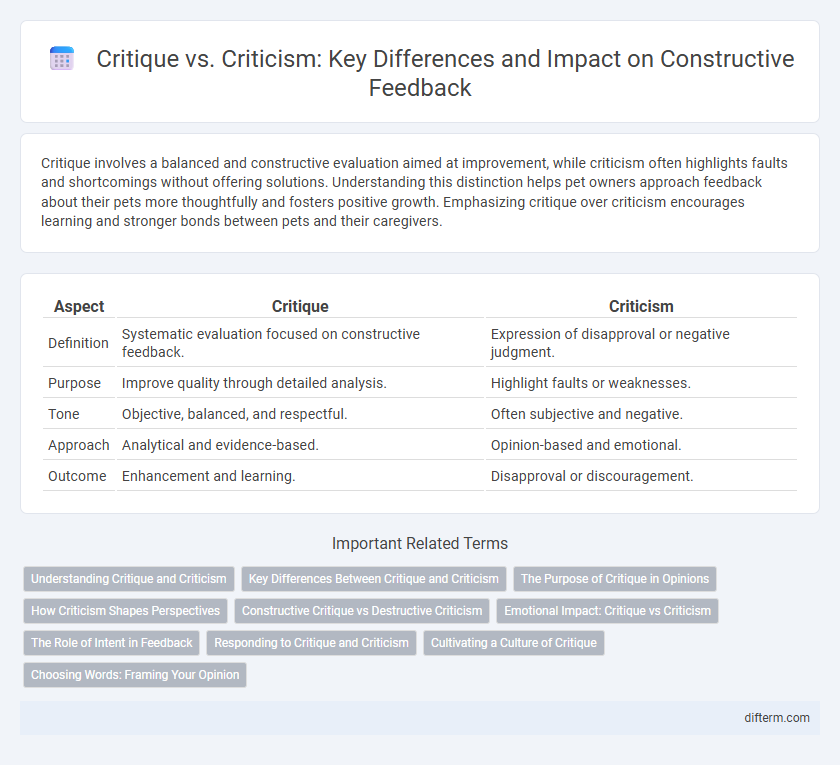Critique involves a balanced and constructive evaluation aimed at improvement, while criticism often highlights faults and shortcomings without offering solutions. Understanding this distinction helps pet owners approach feedback about their pets more thoughtfully and fosters positive growth. Emphasizing critique over criticism encourages learning and stronger bonds between pets and their caregivers.
Table of Comparison
| Aspect | Critique | Criticism |
|---|---|---|
| Definition | Systematic evaluation focused on constructive feedback. | Expression of disapproval or negative judgment. |
| Purpose | Improve quality through detailed analysis. | Highlight faults or weaknesses. |
| Tone | Objective, balanced, and respectful. | Often subjective and negative. |
| Approach | Analytical and evidence-based. | Opinion-based and emotional. |
| Outcome | Enhancement and learning. | Disapproval or discouragement. |
Understanding Critique and Criticism
Critique involves a balanced evaluation that highlights both strengths and weaknesses, fostering growth and deeper understanding. Criticism often emphasizes faults and negative aspects, potentially discouraging constructive feedback. Grasping the distinction between critique and criticism is essential for effective communication and improvement in various fields.
Key Differences Between Critique and Criticism
Critique involves a detailed and balanced evaluation aimed at improvement, while criticism often highlights faults or shortcomings, sometimes perceived as negative. A key difference lies in intent: critique seeks constructive feedback, whereas criticism may lack constructive elements. Understanding this distinction enhances communication and fosters growth in various fields.
The Purpose of Critique in Opinions
Critique in opinions serves the purpose of constructive evaluation aimed at improvement, distinguishing it from criticism which often highlights faults without offering solutions. The objective of critique is to provide balanced insights that foster growth and deeper understanding. This method encourages open-minded dialogue and positive development rather than mere judgment.
How Criticism Shapes Perspectives
Criticism plays a crucial role in shaping perspectives by challenging existing beliefs and encouraging deeper analysis of ideas or actions. Through constructive criticism, individuals can identify weaknesses and areas for improvement, fostering intellectual growth and innovation. This process amplifies understanding by prompting reflection and dialogue, ultimately refining knowledge and viewpoints.
Constructive Critique vs Destructive Criticism
Constructive critique focuses on providing specific, actionable feedback aimed at improvement, fostering growth and development in personal or professional contexts. Destructive criticism, however, often targets the individual rather than the work, using negative language that undermines confidence and stifles progress. Emphasizing respectful communication and clear intentions transforms critique into a valuable tool for positive change.
Emotional Impact: Critique vs Criticism
Critique provides constructive feedback that fosters growth and learning, often delivered with a balanced emotional tone that encourages improvement. Criticism tends to highlight faults or mistakes, which can trigger defensive emotions and hinder positive development. Understanding the emotional impact of these approaches is essential for effective communication and personal growth.
The Role of Intent in Feedback
Critique emphasizes constructive feedback aimed at improvement, focusing on intent to guide growth and understanding. Criticism often highlights faults and shortcomings, sometimes lacking the supportive intent necessary for positive change. The role of intent distinguishes critique as a tool for development, whereas criticism can be perceived as judgment or disapproval.
Responding to Critique and Criticism
Responding to critique involves acknowledging constructive feedback with openness and a willingness to improve, fostering growth and learning. Criticism, often perceived as negative, requires a balanced response that separates personal emotion from objective evaluation to maintain professionalism. Effective responses to both critique and criticism enhance communication, encourage dialogue, and lead to better outcomes in personal and professional settings.
Cultivating a Culture of Critique
Cultivating a culture of critique fosters open dialogue and continuous improvement by emphasizing constructive feedback rather than destructive criticism. This environment encourages individuals to engage thoughtfully, promoting growth and innovation within teams and organizations. Emphasizing respectful critique enhances collaboration, trust, and the development of creative solutions.
Choosing Words: Framing Your Opinion
Critique and criticism serve distinct roles in shaping opinions, with critique offering constructive analysis and criticism often implying judgment or disapproval. Choosing precise words like "evaluate" or "assess" in a critique frames feedback as insightful and balanced, while terms like "blame" or "fault" in criticism can convey negativity and bias. Framing opinions with clear, objective language enhances understanding and encourages productive dialogue.
Critique vs Criticism Infographic

 difterm.com
difterm.com